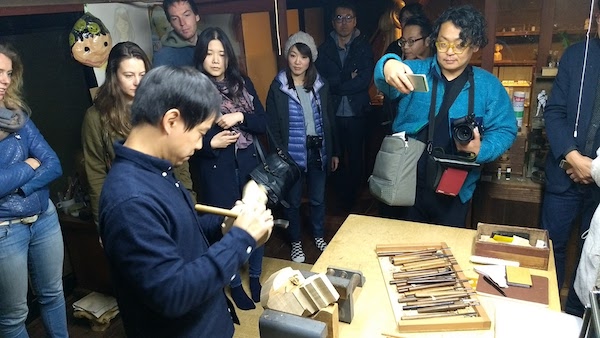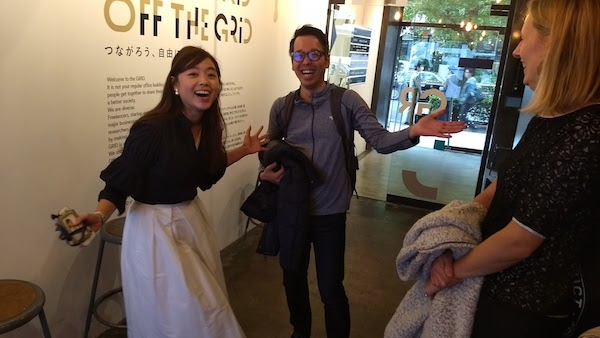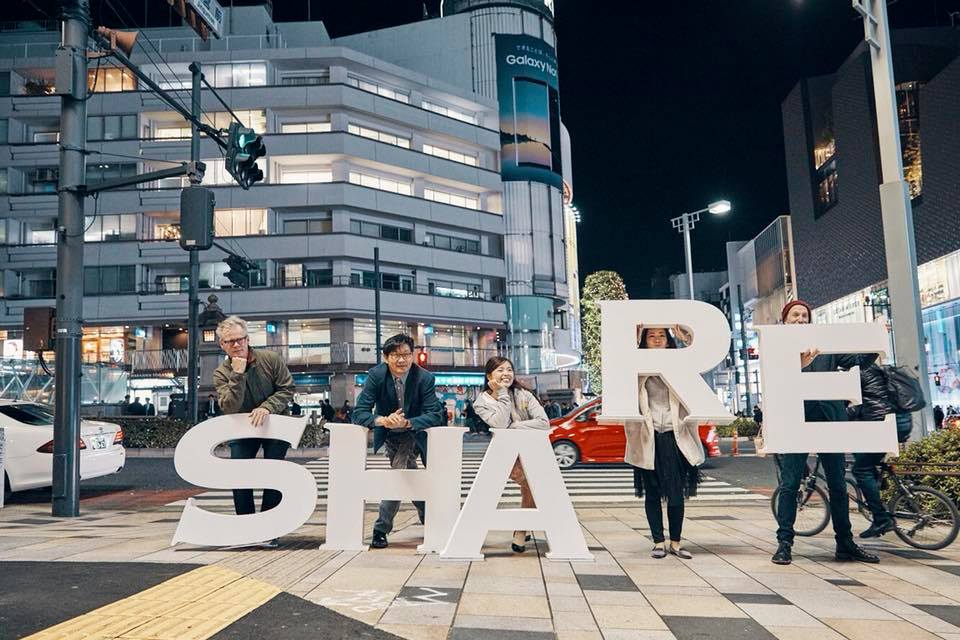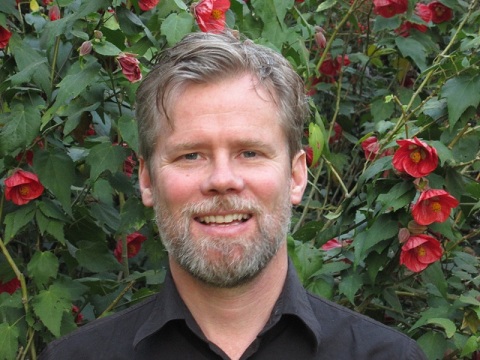Last November, I joined an international delegation to speak at the Sharing Economy Association Japan's (SEAJ) annual Share Summit in Tokyo and explore sharing in Japan. Thanks to the incredible hospitality of SEAJ (which I advise), it was one of the most rewarding learning experiences of my life. In the following photo essay, Pieter van de Glind of ShareNL and I share just some of the highlights of our experience in pictures. Why do this together? Pieter and I decided to deepen cooperation between ShareNL and Shareable while in Takayama, and to start with this post. Pieter's contributions are preceded by his initials PG. The rest is mine.

The Share Summit featured two action-packed days of sessions.The ambitious agenda enabled the SEAJ to cover many facets of sharing in Japan, from platforms like Space Market (rent a temple or an island) to government regulation, to Sharing Cities — all under the theme of "Share or Die." SEAJ couched sharing as a solution to core challenges in Japan like the slowing economy, an aging population, and rural outmigration which made the content relevant to participants and SEAJ's mission to revitalize Japan through the sharing economy.
PG: In Japan, only 30 percent of the citizens know what the sharing economy is. The Share Summit took place in the heart of Tokyo (the Shibuya ward) to put the Japanese sharing economy on the map and increase awareness of the opportunities for Japanese citizens, governments, and other organizations to share.
I was honored to give one of the opening keynotes, but a highlight for me was the ceremony certifying 15 new Sharing Cities, which the above photo captures, as it showed SEAJ's deep commitment to a movement Shareable helped launch in San Francisco over six years ago. It was inspiring to be part of something bigger than myself with so much promise to empower people.

Another moment stood out too. In an interview with The Japan Times, I said that Japan's cautious approach to the sharing economy was an opportunity to learn from other countries and do it better. That may be true, but the question I answered was based on the premise that Japan is behind in the sharing economy. Had I been interviewed at the end of my stay, I might have said this instead — that Japan's culture of respect, trust, and personal responsibility enables residents to co-create large-scale, shared urban environments like Tokyo that are remarkably safe, clean, and enjoyable. That's more powerful than any sharing economy app.
Check out the videos for Share Summit here (day 1) and here (day 2).
The conference featured a popup coworking area in a nearby garage with local food, crafts, wifi, and lounge space. Above I'm offered Takoyaki (grilled dough balls with diced octopus) one of Japan's most popular snacks.

After the conference wrap party at the garage, the SEAJ gang and I partake in ramen, arguably Japan's national dish and a staple of late night, after-party fare. SEAJ and ANA, one of Japan's main airlines, took the international delegation to tour historic Takayama City and the neighboring area, which is a great place to get a taste of traditional Japan and Japanese sharing both old and new. We touched down in nearby Toyama for a sushi lunch at the airport. Tip: if you're seated next to the hot water faucet at a traditional sushi joint, you’re expected to make tea for the table.

From the airport, we took a bus to Zenkō-ji temple, our lodging in Takayama City. Available on Otera Stay, an Airbnb for temple stays, Zenkō-ji is a functioning Zen Buddhist (Pure Land branch) temple that offers tourist lodging to help fund upkeep. Pictured above is the ceremonial area. Under it is a maze you must navigate in the dark. The maze makes an irresistible offer — if you find the lock to a door which secures a statue of Buddha, all your sins will be forgiven. I found the lock. I'm not sure about the sins part, but I was definitely left with rare sense of wonder. I was brought back to earth by the shared rooms and tatami mats that our party slept on that night. It was cozy.

Strolling the streets of old town Takayama City, a historic city in the foothills of Japanese Alps whose 17th century center has survived wars, fires, and earthquakes. Its old downtown now caters to tourists, but with remarkable restraint.
PG: We witnessed firsthand how tourism is moving from selling destinations to offering experiences. Takayama attracts today's experience seekers. Together with the local tourism industry, they expand possibilities for travelers. We didn't sleep in a hotel, but in a temple, tried our archery skills among skilled locals, and were given a traditional dinner that let us experience authentic Japanese hospitality. The Japanese tourism industry is connecting these experiences to large online platforms as well as in local markets across the globe. For instance, Japanese sake makers are exhibiting at local markets in wine regions elsewhere to attract some of those wine-lovers to a true Japanese sake experience.

The okami-san (woman in charge at an inn or restaurant) introduces dinner at a traditional Japanese restaurant in Takayama City. The international delegation was seated in the place of honor. Shortly after I took this picture, SEAJ's Takashi Sabetto stood in front of us to give a touching dedication honoring us, pledging friendship, and looking forward to more collaboration.

After dinner, we went downtown for a traditional Japanese archery (kyūdō) lesson. It was challenging. I hit the target once out of ten shots. The locals shooting with us showed us how it's done. They were impressive.

The next day we went to Co-Ba coworking walking distance from the temple. In the above picture, Takashi presents SEAJ's Sharing Cities work to Takayama City officials.

A glass of delicious matcha beer, which is beer mixed with green tea powder. Co-Ba has it on tap. We shared a glass. Thank you Co-Ba! You can make it at home, here's how.

Afterwards, we took a bus to Fresh Lab in the suburbs of Takayama. Fresh Lab is a training center, shared kitchen, and makerspace in a grocery store. Why not?

Our next stop was the old farming area of Gokayama in the mountains outside of Nanto City. It's an UNESCO World Heritage Site due to its rare collection of gassho-zukuri houses, a traditional architecture style featuring rice straw thatched roofs supported by rope-lashed timber frames (no nails!). Some of the houses are over 300 years old. Traditional Japanese village life is rich in sharing — the maintenance of houses and rice paddies requires regular, intensive collective effort. Village associations found in many small Japanese towns, a practice that is sometimes reproduced in neighborhoods of big cities. Japan, like many nations, is experiencing rapid rural out-migration. Much of SEAJ's Sharing Cities work is to help rural towns stay vibrant, partly by making the most of what remains.

Pieter and Takashi share a lunch of local fresh fish and vegetables in one of the thatched houses. The room is heated by an old-fashioned hibachi (fire bowl or box).
PG: Many small towns in Japan are in decline, having a shrinking and aging population. But bigger is not always better. In Japan, we saw signs of a new form of urbanization. Small cities like Nanto (pop. 50,000) are finding ways to attract and keep young people and families. To accomplish this, they need to offer more opportunities than farming, tourism, and public services. Nanto is trying to keep tech talent in town by helping to build coworking spaces for them and growing a niche in the computer game industry. They hope to attract young talent from big cities like Tokyo to revive the town. Those who stay or move to Nanto will benefit from affordable housing, being close to nature, better air quality, and more.

While in Nanto, we stopped at Bed and Craft, a guest house that links visitors to local wood carvers, which Nanto's Inami district is famous for. The house was lovingly renovated and is run by local architect Tomotsugu Yamakawa. The interior takes full advantage of the local woodworking talent. It's beautiful, inviting, and cozy inside.

We got a demonstration by a master wood sculptor, Komei Tanaka, whose studio located just down the street. I had a great time in the Takayama area with my fellow Share Summit speakers Sanku Jo (Kozaza), Anouk Ruhaak (Embassy Network), Lenneke van Rossum (Seats2Meet), Pieter van de Glind (ShareNL), and the SEAJ team thanks to SEAJ and Keiichi Yamada of ANA.

Back in Tokyo, I spent an afternoon with Todd Porter of Edgeof innovation center. Todd took me to his local izakaya (a pub meets tapas bar Japanese style). I loved it. You sit or stand elbow-to-elbow with other guests. You pass food to other diners over the counter. Everyone seems to know each other. The food is delicious, affordable, and the small plates are meant to be shared. I can see why izakaya is a Japanese institution. While we ate the grilled fare, Todd and I talked about the transformational potential of sharing and Edgeof.
I had a busy couple of days before returning home. I paneled about Sharing Cities with Nanette Schippers, program manager of the sharing economy for the city of Amsterdam, and Akiyuki Minami of SEAJ at Dive Diversity Summit Shibuya. We met with the mayor of Shibuya, Ken Hasebe. I presented him a copy of our book and opened lines of cooperation. Among other things, he's working to increase the diversity of and sharing in Shibuya with SEAJ's help.

I toured the Nagatacho Grid coworking space (home of SEAJ, sleep capsules in the library!) and took an e-bike trip through the Nagatacho district of Tokyo with the SEAJ team.
Then Japan's famous Sharing Girl, Anju Ishiyama, and friends threw a birthday party for me at Shibuya Cast’s (a coliving community) shared kitchen. We were treated to an improv dance performance, Anju sang for the group, and we all cooked together (okonomiyaki!). I was simply blown away by how fun, creative, and big-hearted this group is. It was one of the most memorable birthdays ever.

On my last work day in Japan, I met with representatives from SEAJ member companies Tadaku (learn traditional cooking at a local’s home), Tabica (skill and experience sharing), and Notteco (long distance ride sharing) — a few of the services that can help smaller cities and rural towns thrive through peer-to-peer connections between visitors and locals. I saw a completely new way to experience Japan that isn't understood by the average tourist, at least yet.
I also met with the SEAJ secretariat to present them with copies of our new book and to explore further collaboration. Below, the SEAJ team sees me off. Thank you (from left to right) Takashi Sabetto, Hideaki Ninomiya, Anju Ishiyama, Hiroyo Koike Koizumi, Iris Wang, Megumi Minoguchi, Aiko Fujii (and everyone I met) for the best introduction to Japan one could imagine.
Header image courtesy of Anju Ishiyama









